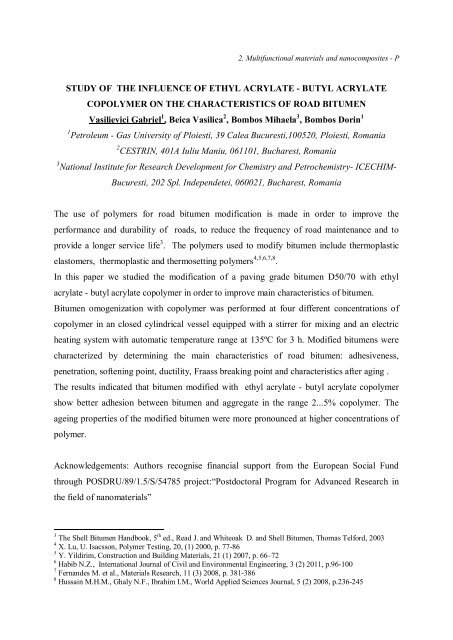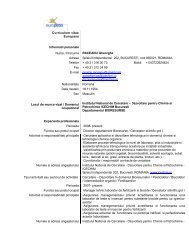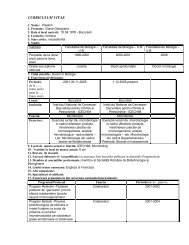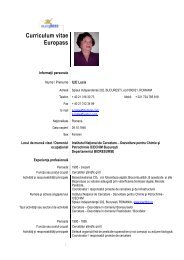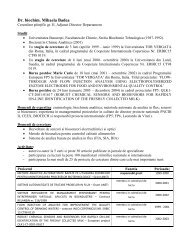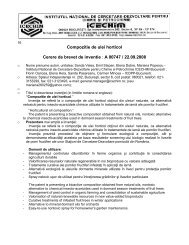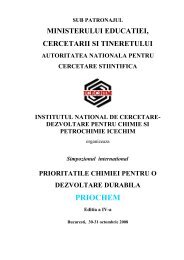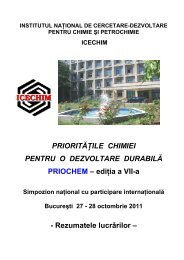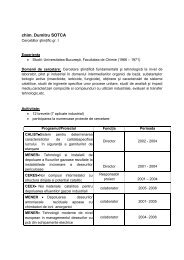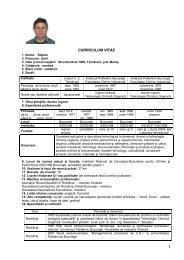INSTITUTUL NAÅ¢IONAL DE CERCETARE-DEZVOLTARE - ICECHIM
INSTITUTUL NAÅ¢IONAL DE CERCETARE-DEZVOLTARE - ICECHIM
INSTITUTUL NAÅ¢IONAL DE CERCETARE-DEZVOLTARE - ICECHIM
- No tags were found...
Create successful ePaper yourself
Turn your PDF publications into a flip-book with our unique Google optimized e-Paper software.
2. Multifunctional materials and nanocomposites - PSTUDY OF THE INFLUENCE OF ETHYL ACRYLATE - BUTYL ACRYLATECOPOLYMER ON THE CHARACTERISTICS OF ROAD BITUMENVasilievici Gabriel 1 , Beica Vasilica 2 , Bombos Mihaela 3 , Bombos Dorin 11 Petroleum - Gas University of Ploiesti, 39 Calea Bucuresti,100520, Ploiesti, Romania2 CESTRIN, 401A Iuliu Maniu, 061101, Bucharest, Romania3 National Institute for Research Development for Chemistry and Petrochemistry- <strong>ICECHIM</strong>-Bucuresti, 202 Spl. Independetei, 060021, Bucharest, RomaniaThe use of polymers for road bitumen modification is made in order to improve theperformance and durability of roads, to reduce the frequency of road maintenance and toprovide a longer service life 3 . The polymers used to modify bitumen include thermoplasticelastomers, thermoplastic and thermosetting polymers 4,5,6,7,8 .In this paper we studied the modification of a paving grade bitumen D50/70 with ethylacrylate - butyl acrylate copolymer in order to improve main characteristics of bitumen.Bitumen omogenization with copolymer was performed at four different concentrations ofcopolymer in an closed cylindrical vessel equipped with a stirrer for mixing and an electricheating system with automatic temperature range at 135ºC for 3 h. Modified bitumens werecharacterized by determining the main characteristics of road bitumen: adhesiveness,penetration, softening point, ductility, Fraass breaking point and characteristics after aging .The results indicated that bitumen modified with ethyl acrylate - butyl acrylate copolymershow better adhesion between bitumen and aggregate in the range 2...5% copolymer. Theageing properties of the modified bitumen were more pronounced at higher concentrations ofpolymer.Acknowledgements: Authors recognise financial support from the European Social Fundthrough POSDRU/89/1.5/S/54785 project:“Postdoctoral Program for Advanced Research inthe field of nanomaterials”3 The Shell Bitumen Handbook, 5 th ed., Read J. and Whiteoak D. and Shell Bitumen, Thomas Telford, 20034 X. Lu, U. Isacsson, Polymer Testing, 20, (1) 2000, p. 77-865 Y. Yildirim, Construction and Building Materials, 21 (1) 2007, p. 66–726 Habib N.Z., International Journal of Civil and Environmental Engineering, 3 (2) 2011, p.96-1007 Fernandes M. et al., Materials Research, 11 (3) 2008, p. 381-3868 Hussain M.H.M., Ghaly N.F., Ibrahim I.M., World Applied Sciences Journal, 5 (2) 2008, p.236-245


